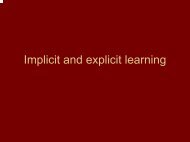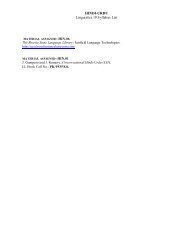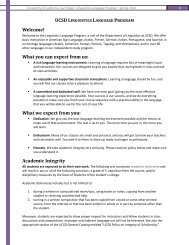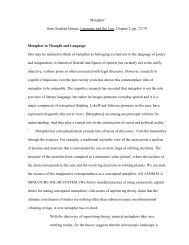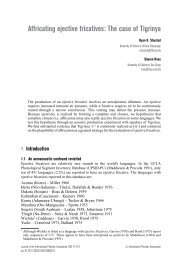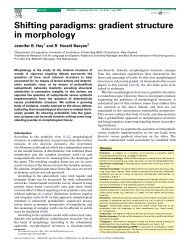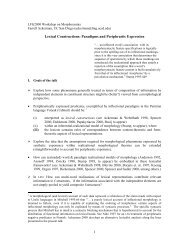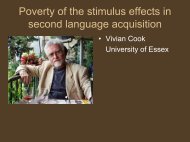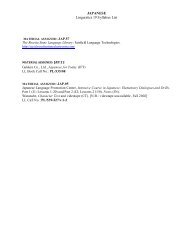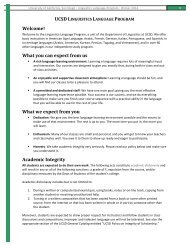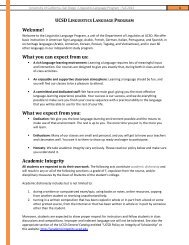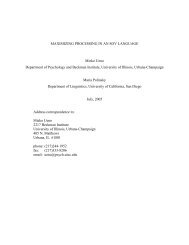The morphological structure of the Moro verb Sharon Rose
The morphological structure of the Moro verb Sharon Rose
The morphological structure of the Moro verb Sharon Rose
Create successful ePaper yourself
Turn your PDF publications into a flip-book with our unique Google optimized e-Paper software.
<strong>The</strong> <strong>morphological</strong> <strong>structure</strong> <strong>of</strong> <strong>the</strong> <strong>Moro</strong> <strong>verb</strong><br />
(28) 1DU.INC álə́-ʧombəð-a we two are about to tickle<br />
1PL.INC álə́-ʧombəð-a-r we all are about to tickle<br />
2SG PROX.IMP ʧómbə́ð-ó tickle!<br />
2PL PROX.IMP ʧómbə́ð-ó-r tickle! (pl.)<br />
If <strong>the</strong>re is more than one object marker, only one can appear as a prefix, and<br />
<strong>the</strong> o<strong>the</strong>r must appear as a suffix. See <strong>Rose</strong> & Jenks (2011) for more details.<br />
<strong>The</strong> object prefixes appear before <strong>the</strong> durative/iterative prefix, and cannot<br />
co-occur with <strong>the</strong> progressive v-prefix. This latter restriction is<br />
morphophonological ra<strong>the</strong>r than semantic, as v- can co-occur with <strong>the</strong> 3PL -lo<br />
object marker: g-ʌ́-ɲ-ʌnd-iə ‘he is about to hold me’ versus g-ʌ-v-ʌńd-iə-lo ‘he is<br />
about to hold <strong>the</strong>m’. <strong>The</strong> H tone from <strong>the</strong> object prefix shifts to <strong>the</strong> previous<br />
vowel.<br />
<strong>The</strong> H tone which normally appears on <strong>the</strong> root or on <strong>the</strong> durative/iterative<br />
prefix is absent when an object prefix is present. <strong>Rose</strong> & Jenks (2011) argue<br />
that <strong>the</strong> H tone <strong>of</strong> <strong>the</strong> object marker functions as <strong>the</strong> default tone <strong>of</strong> <strong>the</strong> <strong>verb</strong><br />
stem, obviating <strong>the</strong> need to position a H tone on <strong>the</strong> <strong>verb</strong> root. Ano<strong>the</strong>r<br />
possible analysis is to treat this as a type <strong>of</strong> tone dissimilation effect, in<br />
which only a single H tone is allowed at <strong>the</strong> left edge <strong>of</strong> <strong>the</strong> macrostem.<br />
Finally, like <strong>the</strong> durative/iterative prefix, vowel harmony can affect <strong>the</strong><br />
object prefix: e.g. g-ʌ-ŋʌ́-dəɾ-iə ‘he is about to cover you’.<br />
To summarize, <strong>the</strong> durative/iterative prefix, <strong>the</strong> progressive prefix, and <strong>the</strong><br />
object marker all affect <strong>the</strong> distribution <strong>of</strong> default H tone. <strong>The</strong> leftmost<br />
element in <strong>the</strong> macrostem bears H tone, and <strong>the</strong> o<strong>the</strong>r elements do not. We<br />
now turn to <strong>the</strong> o<strong>the</strong>r prefixes in <strong>the</strong> <strong>verb</strong> stem, many <strong>of</strong> which have H tone<br />
that co-occurs with default H tone. We maintain that this constitutes<br />
evidence for <strong>the</strong> macrostem boundary.<br />
5. Verb stem prefixes<br />
<strong>The</strong> prefixes that occur to <strong>the</strong> left <strong>of</strong> <strong>the</strong> macrostem boundary are as<br />
follows 10 .<br />
10 It is possible that <strong>the</strong>re is also a tense prefix developing in <strong>the</strong> language.<br />
For example, <strong>the</strong> form á-gá-g-a-t ̪əŋat ̪-ó ‘you had licked it’ suggests a<br />
reduplicative prefix gá- with H tone that copies <strong>the</strong> elements to its right.<br />
However, this ‘prefix’ appears to be <strong>the</strong> fusion <strong>of</strong> <strong>the</strong> <strong>verb</strong> ‘to be’ with a<br />
following <strong>verb</strong> with <strong>the</strong> same subject, clause and aspect marking, giving <strong>the</strong><br />
appearance <strong>of</strong> reduplication: á-g-a(w)-ó á-g-a-t ̪əŋat ̪-ó → ágágat ̪əŋat ̪ó. <strong>The</strong>re is<br />
no vowel harmony between <strong>the</strong> two, an indication <strong>of</strong> separate words: né-n-i-<br />
15



